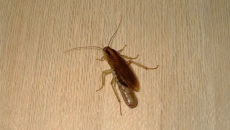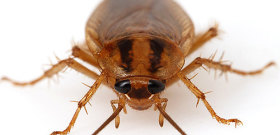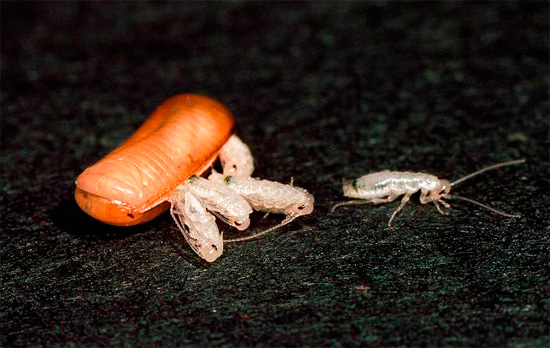
Next you will learn:
- how many cockroaches hatch from one egg;
- what cockroach eggs and egg capsules (so-called ootheca) look like and how many eggs are contained in one such capsule;
- how and where the process of laying eggs and the subsequent birth of young cockroaches takes place;
... as well as other interesting facts regarding the "birth" of cockroaches from eggs.
It may seem strange to someone, but only one tiny larva hatches from one cockroach egg, which later, after several molts, turns into an adult insect. This is important: in one egg there is only one cockroach.
It is not difficult to explain this: a larger number of larvae simply will not fit here, and the egg itself is a developing egg that can turn into only one embryo.
In the photo - cockroach eggs:
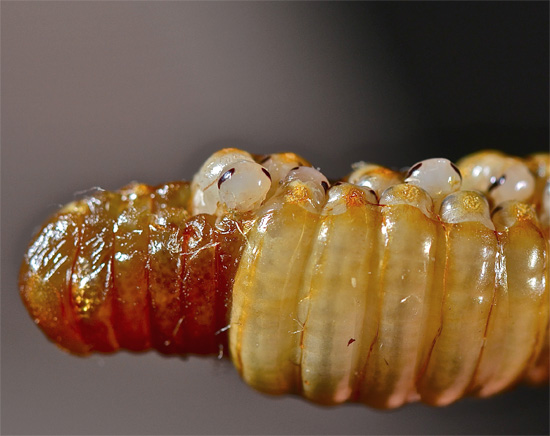
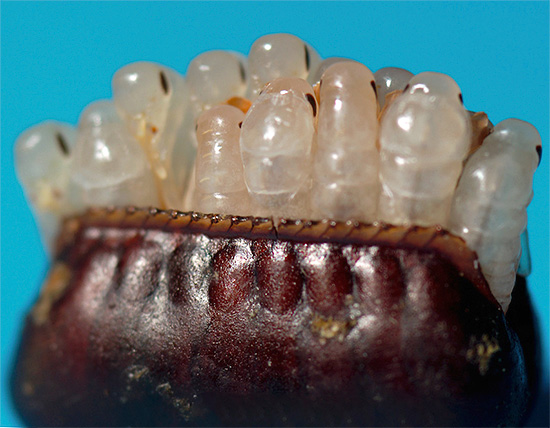
On a note
Purely theoretically, two twin larvae can develop from one cockroach egg, as in other animals. However, such cases are very rare, and, in general, exactly one cockroach almost always develops from one egg.
It is important not to confuse the egg itself with a special egg capsule, or ootheca, in which many such eggs are placed. By the way, it is precisely because of the compact swelling that the “pregnant” female of the red cockroach carries with her that many people believe that there are many future pests in one cockroach egg - they confuse the capsules themselves with eggs.

Let's touch on this point in more detail and see how many cockroach eggs are in the ootheca and how such a capsule is arranged.
Cockroach eggs and egg capsules (ootheca)
The eggs of almost all types of cockroaches are still in the body of the female "packed" in a special shell, which quickly solidifies in air and forms a characteristic capsule.

Such a capsule is called an ootheca (from the Greek "oo" - egg, "tekos" - storage) and serves to protect vulnerable eggs from adverse environmental factors. It is she who ensures the high survival of cockroaches both in nature and in human housing.
On a note
Ooteka is also found in other species of invertebrates: in addition to cockroaches, it is, for example, characteristic of praying mantises and mollusks.
Cockroach ootheca can have a different shape, size and color, depending on the type of insect. For example:
- the ootheca of black cockroaches is dark brown in color, about 12 mm long, about 6 mm wide, and has a clearly visible ridge on the surface;
- Prusak's ootheca is red, about 8 mm long, with clearly visible transverse constrictions;
- in the Madagascar cockroach, the ootheca is strongly elongated in length, has a light yellow color, and measures about 25x4 mm.
The photo below shows the appearance of the Prusak ootheca:

And in the following photo you can clearly see what the ootheca of the Madagascar hissing cockroach looks like:
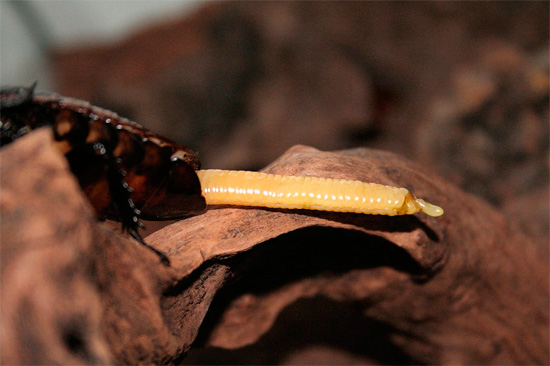
Despite the relatively high strength and hardness of the wall, the ootheca allows the developing embryos to breathe, thus resembling the shell of a bird's egg.
How many eggs are in each ootheca is determined by the type of cockroach. For example, in red cockroaches, each such capsule contains an average of 20-30 eggs, rarely up to 50. They lie very close to each other in 4 even rows - two in height and two in width.
The eggs themselves are tiny - about 1 mm long and a few tenths of a millimeter wide. They are light yellow or white, translucent, and through their shell you can even see the embryo with a magnifying glass.
The photo below shows what cockroach eggs look like inside an ootheca:
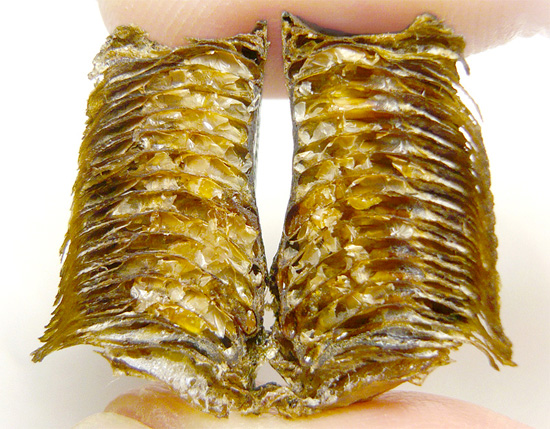
An ootheca is formed during the laying of eggs by a cockroach. In a special chamber in the abdomen of the female, a large amount of sticky secretion is released, into which the eggs coming from a special organ are literally dipped.
And further: But the Reid aerosol really works - cockroaches die quickly. Watch our video...
When the process of egg formation ends, the secret is released for some more time, closing the ootheca from the inside. By this time, in most species of cockroaches, the capsule for a significant part of its length leaves the body of the "pregnant" female and remains attached to the end of the abdomen for some time.
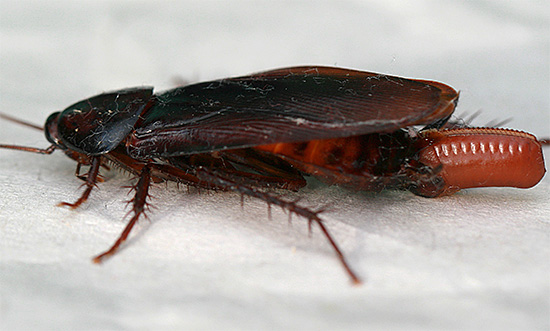
In this capsule, cockroach eggs develop from 30 to 75 days. Development proceeds most rapidly under conditions of high temperature (above 30°C) and humidity, but when the temperature drops below 15°C, their development stops, resuming with the return of heat. This allows the population to survive the cold.
It is interesting
An adult Prussian dies at temperatures below -5°C and above +45°C, while its ootheca normally tolerates short-term cooling to -10°C and overheating to +55°C. In addition, insecticides have little effect on ootheca (and many of them have little or no effect). For example, in Prussians, whose females carry a capsule at the end of the abdomen until the end of larval development, if the mother dies from exposure to the insecticide, then the eggs in the ootheca continue to develop, and later young nymphs hatch from them anyway.
Different species take care of eggs and their protective capsule in different ways.
For example, female black cockroaches lay edema, and thus leave their eggs to fend for themselves as early as 3-4 days after the ootheca is fully formed. Then, for almost two more months, the capsule develops without any protection. If predators or parasites find such an ootheca at this time, they will destroy the eggs. In many ways, this is why red cockroaches are replacing blacks everywhere - they just eat their eggs.
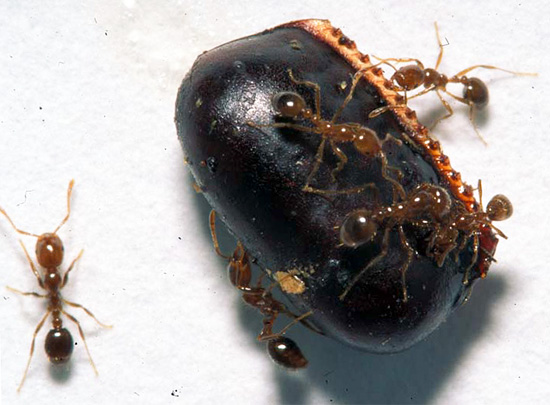
The Prussians themselves, as well as various exotic species, for example, ashy and Madagascar cockroaches, show a certain concern for their offspring. Female red cockroaches carry an ootheca at the end of their abdomen until the larvae hatch, and they can at least carry it away from danger.
And in the same Madagascarians, the ootheca develops in the body cavity, and only a few times a day the “pregnant” cockroach puts it outside for ventilation. The larvae also hatch inside the mother's body, but leave the brood chamber almost at the same moment. The observer of this process has the feeling that the cockroach is giving birth (that it is allegedly viviparous), although in fact all cockroaches, without exception, lay eggs, it’s just that in some species, the development of eggs to the stage of the larva proceeds inside the mother’s abdomen.
The photos below show how a female Madagascar hissing cockroach "gives birth":
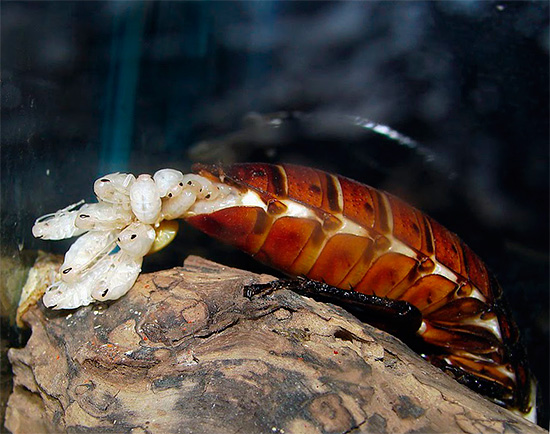
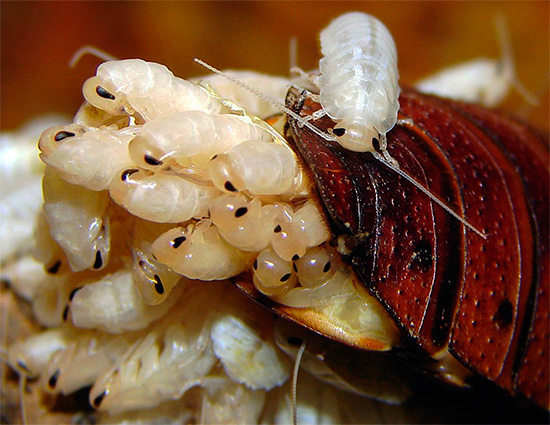
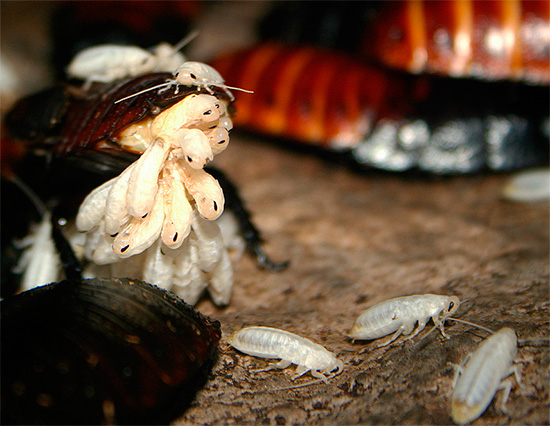
Depending on the type of cockroach, the number of “pregnancies” and the number of ooteks carried by the female throughout her life also varies. Thus, a Prusak female can produce up to 9 capsules in her life (of which more than 250 larvae are “born” in total), although usually an “average” female produces about 3-4 ootheca in her life.
At the same time, in the female Prusak, the ootheca is clearly visible, and in large tropical species in which the capsule is hidden in the body, it may not be clear that the female is in an interesting position.
How does the process of hatching cockroaches from eggs
Cockroach embryos are constantly moving inside the egg, absorbing the embryonic fluid and nutrients. When they reach such a size that they no longer fit in the egg, they tear its shell and begin to gnaw through the comb of the ootheca.


In those species whose females lay capsules, after the release of the larvae from the ootheca, a strong outer shell remains. In those whose ootheca develops inside the body of the female, its shell is very soft, and by the time the larvae are born, it bursts completely, and the offspring leaves the mother's body in a free state, after which the female gets rid of the remnants of the capsule.
In the video at the end of the article, you can see how cockroaches are "born".
In large species, up to 60 young larvae can hatch at a time, but in general, the normal number of young individuals is 25-35 pieces. The same number of young cockroaches hatch from ootheca of common domestic species.
Further on the photo you can see what the black cockroach ootheca and newborn larvae around it look like:
And further: Good old Karbofos poisons cockroaches with a bang - watch our video ...

As a rule, the whole process of "birth" of cockroaches lasts from several minutes to several hours. After birth, the larvae are usually very light, almost white, but then, as the chitinous cover hardens, they darken.
Are there viviparous cockroaches?
Cockroaches are not viviparous creatures. The terms "ovoviviparous" and "oviparous" are used for these insects.
If the embryo develops in an egg and does not receive nutrition from the mother's body during development, but is in the body of the female, then this method of reproduction is called ovoviviparity.

Those cockroaches whose females simply leave their ootheca to their fate are typical egg-laying insects.The same species in which the eggs develop inside the body of the female, and the nymphs hatch simultaneously with the exit from the brood chamber, are ovoviviparous.
Therefore, the terms "pregnant cockroach" and "viviparous cockroaches" are not entirely correct - only viviparous animals are truly pregnant.
From a scientific point of view, the expression "cockroaches give birth" is not entirely correct. This process is not called childbirth, but hatching.
In the photo - a female Madagascar cockroach with nymphs emerging from her abdomen:
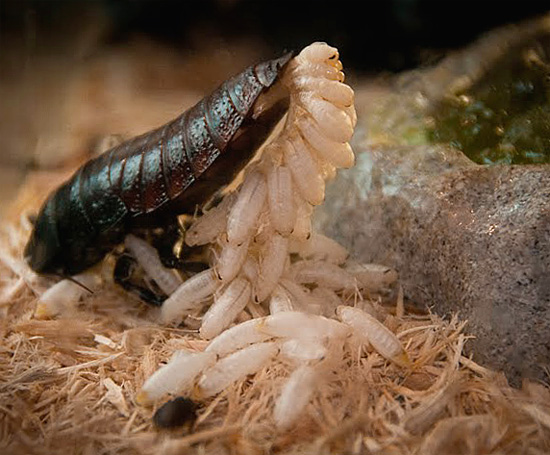
Features of the birth of larvae
For the most part, cockroaches do not show any concern for offspring. Even in the well-known red cockroaches, after the release of the larvae from the ootheca, they simply stay near it for some time, and, consequently, near the female, but within an hour or two they scatter and hide in convenient shelters.
Given that the female tries to lay the ootheca in a place secluded and remote from the main shelter of other adult insects, the first few days the larvae have little contact with other individuals.
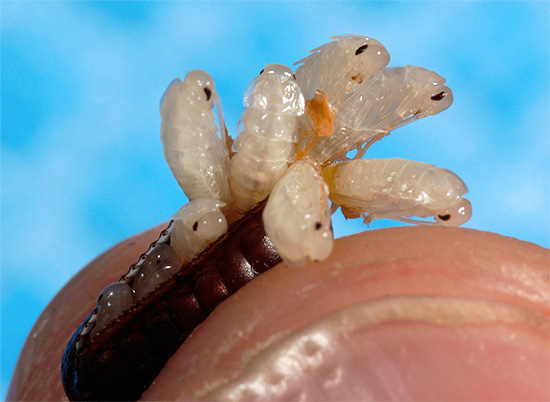
In some tropical species, females take care of newly born larvae. In the same Madagascar cockroaches, babies gather under the belly of their mother, who continues to guard them for several hours, hisses at the approach of the enemy, and can even make frightening attacks. However, by the end of the first day after hatching, young cockroaches crawl away, and the female's maternal worries end there.
On a note
Only relic cockroaches show special care for babies. They live in small colonies with a rudimentary hierarchy, and their offspring are courted as carefully as in termite nests.
Given the fact that cockroach nymphs can feed immediately after hatching, they do not need long-term care, and they quickly become ordinary equal members of the family.
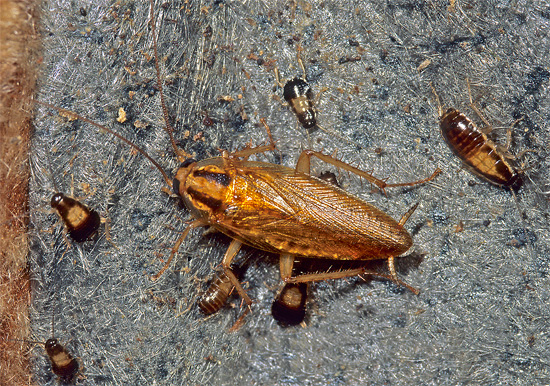
Interestingly, cockroach larvae often try to eat their own ootheca right after they are born. They need it as a source of protein in the first hours of life.
Where do cockroaches lay egg capsules?
The female cockroach tries to lay a capsule with eggs in the most secluded and safe places. In nature, these are spaces under stones, fallen trees, deep under a layer of rotted leaves, and in some species even in the ground or in dry wood.
Similarly, in the apartment - cockroaches lay their eggs here in the safest places, for example:
- in the cracks between the walls of the furniture;
- under bedside tables;
- between the sink and the nightstand under it;
- behind skirting boards;
- in ventilation ducts;
- under the bath;
- on the shelves in the pantry.
Sometimes, when cleaning, the owners of the apartment may catch the eye of dry shells of oothek prusaks - they are already empty, and it is enough just to throw them into the trash can. But if a large black cockroach ootheca is found, it is useful to destroy it, because with a high probability several dozen future pests can hatch from it.
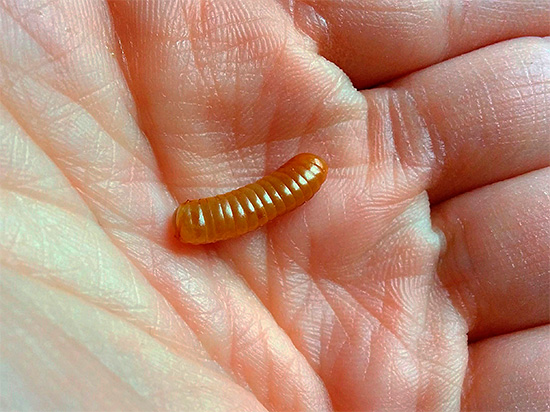
You should not expect that if you raid in search of "eggs" of cockroaches and destroy a few capsules, this will allow you to remove the cockroaches from the apartment completely. Those capsules that can be found will most likely already be empty, but the number of undetected ones will be much larger (red cockroaches carry them with them).
And the search for oothecus itself, even in the case of fighting black cockroaches, is a very time-consuming and ineffective task.It is much more reliable to remove pests by simply disinsection indoors.
Interesting video: Madagascar cockroach "gives birth" (fast playback)







